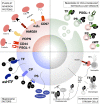Platelets and Metastasis: New Implications of an Old Interplay
- PMID: 33042789
- PMCID: PMC7530207
- DOI: 10.3389/fonc.2020.01350
Platelets and Metastasis: New Implications of an Old Interplay
Abstract
During the process of hematogenous metastasis, tumor cells interact with platelets and their precursors megakaryocytes, providing a selection driver for the metastatic phenotype. Cancer cells have evolved a plethora of mechanisms to engage platelet activation and aggregation. Platelet coating of tumor cells in the blood stream promotes the successful completion of multiple steps of the metastatic cascade. Along the same lines, clinical evidence suggests that anti-coagulant therapy might be associated with reduced risk of metastatic disease and better prognosis in cancer patients. Here, we review experimental and clinical literature concerning the contribution of platelets and megakaryocytes to cancer metastasis and provide insights into the clinical relevance of anti-coagulant therapy in cancer treatment.
Keywords: anti-coagulant therapy; cancer metastasis; coagulation; megakaryocytes; platelets; thromboembolism.
Copyright © 2020 Lucotti and Muschel.
Figures


Similar articles
-
The role of platelets and megakaryocytes in bone metastasis.J Bone Oncol. 2016 Apr 8;5(3):109-111. doi: 10.1016/j.jbo.2016.02.007. eCollection 2016 Sep. J Bone Oncol. 2016. PMID: 27761368 Free PMC article.
-
Platelets are versatile cells: New discoveries in hemostasis, thrombosis, immune responses, tumor metastasis and beyond.Crit Rev Clin Lab Sci. 2016 Dec;53(6):409-30. doi: 10.1080/10408363.2016.1200008. Epub 2016 Jul 22. Crit Rev Clin Lab Sci. 2016. PMID: 27282765 Review.
-
Downregulation of Integrins in Cancer Cells and Anti-Platelet Properties Are Involved in Holothurian Glycosaminoglycan-Mediated Disruption of the Interaction of Cancer Cells and Platelets in Hematogenous Metastasis.J Vasc Res. 2015;52(3):197-209. doi: 10.1159/000439220. Epub 2015 Oct 22. J Vasc Res. 2015. PMID: 26488158
-
Functional role of platelets in experimental metastasis studied with cloned murine fibrosarcoma cell variants.Cancer Res. 1988 Mar 15;48(6):1460-4. Cancer Res. 1988. PMID: 3345518
-
Platelets in Hematogenous Breast Cancer Metastasis: Partners in Crime.In: Mayrovitz HN, editor. Breast Cancer [Internet]. Brisbane (AU): Exon Publications; 2022 Aug 6. Chapter 7. In: Mayrovitz HN, editor. Breast Cancer [Internet]. Brisbane (AU): Exon Publications; 2022 Aug 6. Chapter 7. PMID: 36122158 Free Books & Documents. Review.
Cited by
-
In Ovarian Cancer Multicellular Spheroids, Platelet Releasate Promotes Growth, Expansion of ALDH+ and CD133+ Cancer Stem Cells, and Protection against the Cytotoxic Effects of Cisplatin, Carboplatin and Paclitaxel.Int J Mol Sci. 2021 Mar 16;22(6):3019. doi: 10.3390/ijms22063019. Int J Mol Sci. 2021. PMID: 33809553 Free PMC article.
-
A high-efficiency differential expression method for cancer heterogeneity using large-scale single-cell RNA-sequencing data.Front Genet. 2022 Nov 29;13:1063130. doi: 10.3389/fgene.2022.1063130. eCollection 2022. Front Genet. 2022. PMID: 36523772 Free PMC article.
-
Emerging roles of platelets in cancer biology and their potential as therapeutic targets.Front Oncol. 2022 Jul 22;12:939089. doi: 10.3389/fonc.2022.939089. eCollection 2022. Front Oncol. 2022. PMID: 35936717 Free PMC article. Review.
-
Coagulation/fibrinolysis and circulating tumor cells in patients with advanced breast cancer.Breast Cancer Res Treat. 2022 Apr;192(3):583-591. doi: 10.1007/s10549-021-06484-1. Epub 2022 Feb 8. Breast Cancer Res Treat. 2022. PMID: 35132503 Free PMC article.
-
Bidirectional Interaction Between Cancer Cells and Platelets Provides Potential Strategies for Cancer Therapies.Front Oncol. 2021 Oct 14;11:764119. doi: 10.3389/fonc.2021.764119. eCollection 2021. Front Oncol. 2021. PMID: 34722319 Free PMC article. Review.
References
-
- Trousseau A, Bazire PV, Cormack JR. Lectures on Clinical Medicine, Delivered at the Hotel-Dieu. Paris: New Sydenham Society; (1872).
-
- Trousseau A. Lectures on Clinical Medicine. Philadephia, PA: Lindsay and Blakiston; (1873).
Publication types
LinkOut - more resources
Full Text Sources

